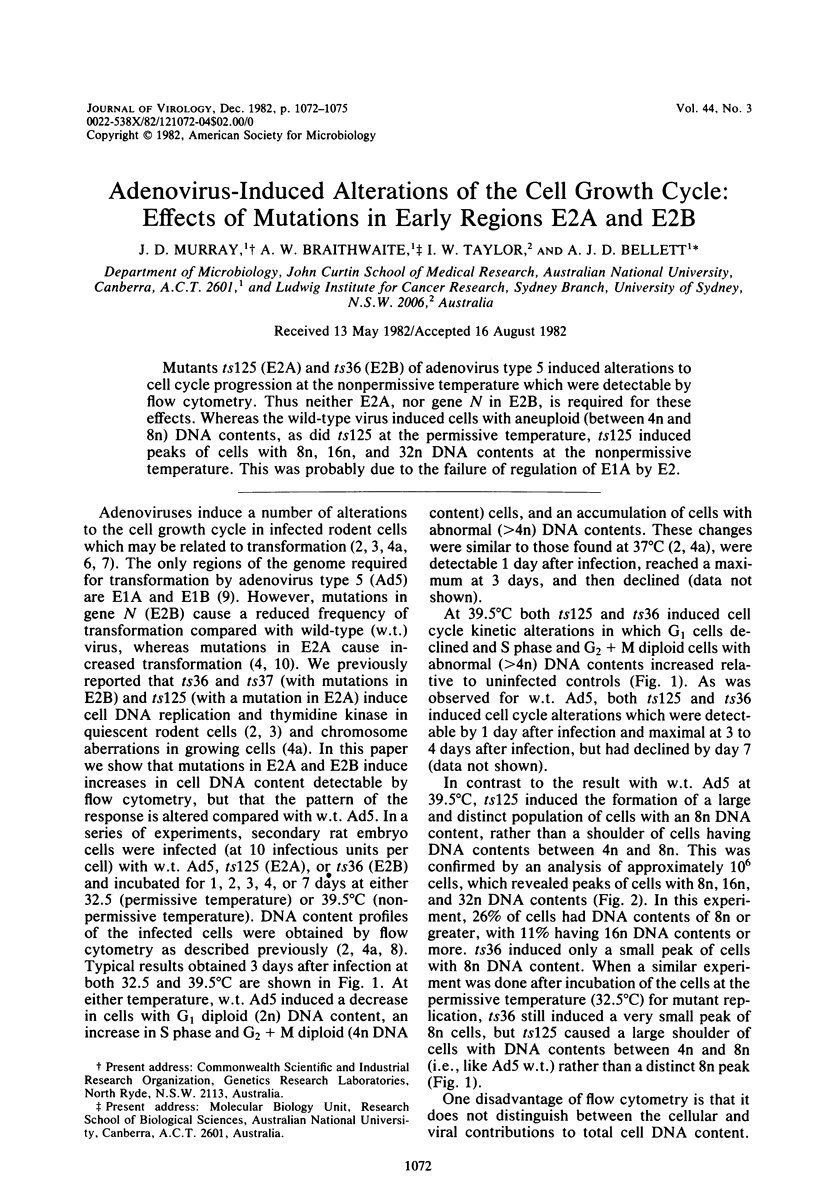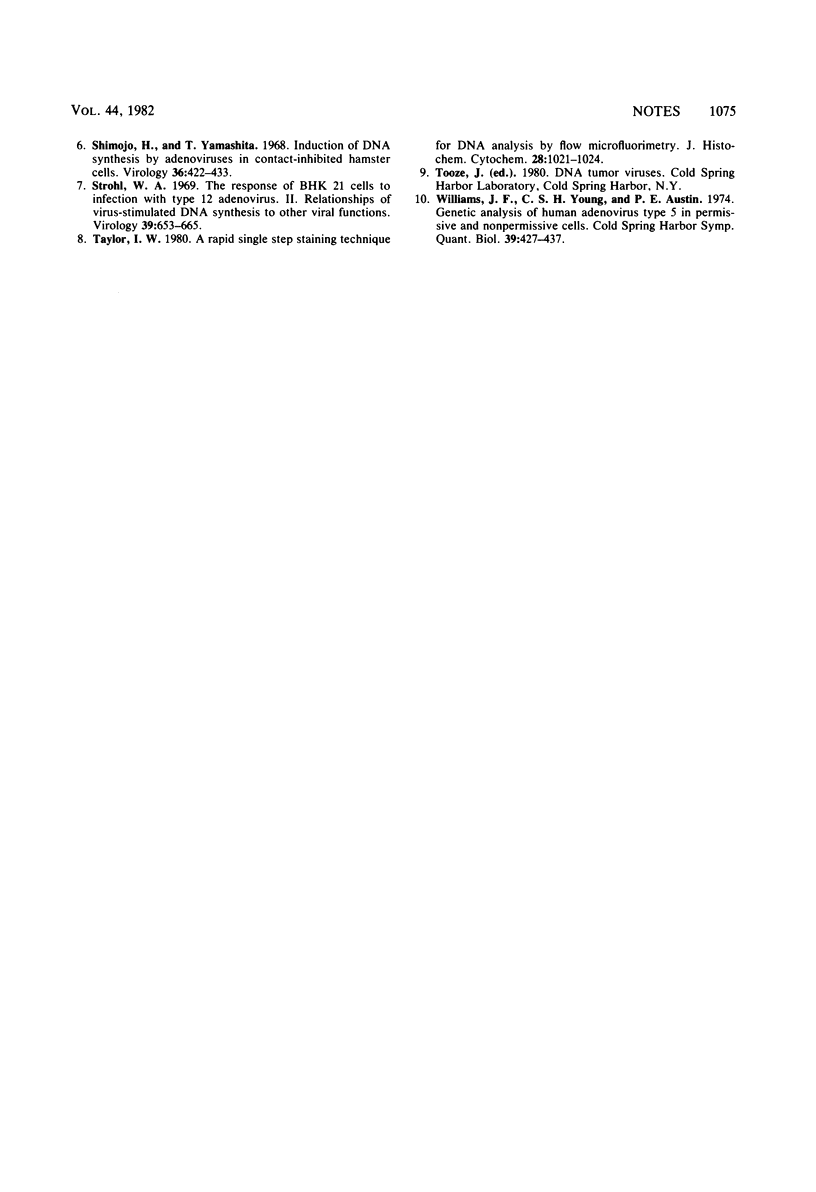Abstract
Mutants ts125 (E2A) and ts36 (E2B) of adenovirus type 5 induced alterations to cell cycle progression at the nonpermissive temperature which were detectable by flow cytometry. Thus neither E2A, nor gene N in E2B, is required for these effects. Whereas the wild-type virus induced cells with aneuploid (between 4n and 8n) DNA contents, as did ts125 at the permissive temperature, ts125 induced peaks of cells with 8n, 16n, and 32n DNA contents at the nonpermissive temperature. This was probably due to the failure of regulation of E1A by E2.
Full text
PDF



Selected References
These references are in PubMed. This may not be the complete list of references from this article.
- Babich A., Nevins J. R. The stability of early adenovirus mRNA is controlled by the viral 72 kd DNA-binding protein. Cell. 1981 Nov;26(3 Pt 1):371–379. doi: 10.1016/0092-8674(81)90206-3. [DOI] [PubMed] [Google Scholar]
- Braithwaite A. W., Murray J. D., Bellett A. J. Alterations to controls of cellular DNA synthesis by adenovirus infection. J Virol. 1981 Aug;39(2):331–340. doi: 10.1128/jvi.39.2.331-340.1981. [DOI] [PMC free article] [PubMed] [Google Scholar]
- Cheetham B. F., Bellett A. J. A biochemical investigation of the adenovirus-induced G1 to S phase progression: thymidine kinase, ornithine decarboxylase, and inhibitors of polyamine biosynthesis. J Cell Physiol. 1982 Feb;110(2):114–122. doi: 10.1002/jcp.1041100203. [DOI] [PubMed] [Google Scholar]
- Ginsberg H. S., Ensinger M. J., Kauffman R. S., Mayer A. J., Lundholm U. Cell transformation: a study of regulation with types 5 and 12 adenovirus temperature-sensitive mutants. Cold Spring Harb Symp Quant Biol. 1975;39(Pt 1):419–426. doi: 10.1101/sqb.1974.039.01.054. [DOI] [PubMed] [Google Scholar]
- Murray J. D., Bellett A. J., Braithwaite A. w., Waldron L. K., Taylor I. W. Altered cell cycle progression and aberrant mitosis in adenovirus-infected rodent cells. J Cell Physiol. 1982 Apr;111(1):89–96. doi: 10.1002/jcp.1041110114. [DOI] [PubMed] [Google Scholar]
- Rossini M., Jonak G. J., Baserga R. Identification of adenovirus 2 early genes required for induction of cellular DNA synthesis in resting hamster cells. J Virol. 1981 Jun;38(3):982–986. doi: 10.1128/jvi.38.3.982-986.1981. [DOI] [PMC free article] [PubMed] [Google Scholar]
- Shimojo H., Yamashita T. Induction of DNA synthesis by adenoviruses in contact-inhibited hamster cells. Virology. 1968 Nov;36(3):422–433. doi: 10.1016/0042-6822(68)90167-0. [DOI] [PubMed] [Google Scholar]
- Strohl W. A. The response of BHK21 cells to infection with type 12 adenovirus. II. Relationship of virus-stimulated DNA synthesis to other viral functions. Virology. 1969 Dec;39(4):653–665. doi: 10.1016/0042-6822(69)90004-x. [DOI] [PubMed] [Google Scholar]
- Taylor I. W. A rapid single step staining technique for DNA analysis by flow microfluorimetry. J Histochem Cytochem. 1980 Sep;28(9):1021–1024. doi: 10.1177/28.9.6157714. [DOI] [PubMed] [Google Scholar]
- Willians J. F., Young C. S., Austin P. E. Genetic analysis of human adenovirus type 5 in permissive and nonpermissive cells. Cold Spring Harb Symp Quant Biol. 1975;39(Pt 1):427–437. doi: 10.1101/sqb.1974.039.01.055. [DOI] [PubMed] [Google Scholar]


